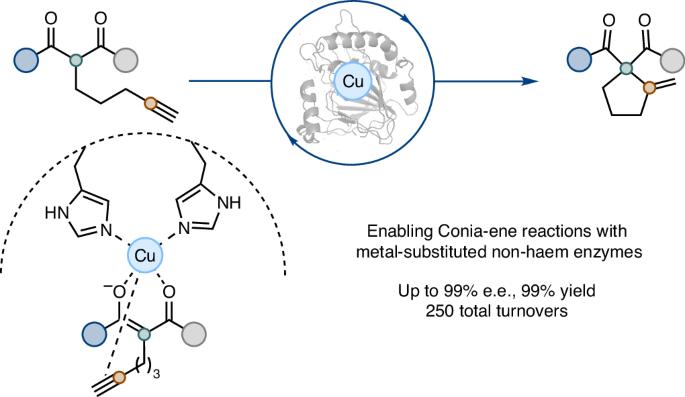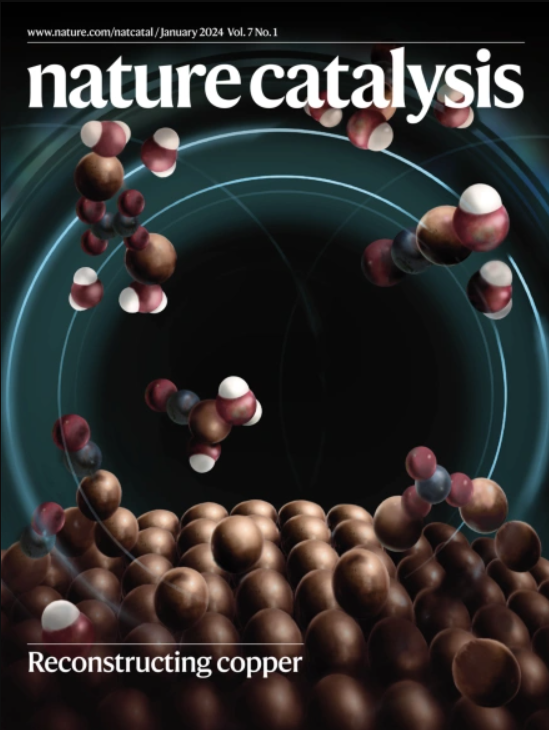Unlocking Lewis acid catalysis in non-haem enzymes for an abiotic ene reaction
IF 44.6
1区 化学
Q1 CHEMISTRY, PHYSICAL
引用次数: 0
Abstract
Lewis acid catalysis is a powerful tool in organic synthesis. However, biocatalytic Lewis acid catalysis has been limited in its reaction scope and diversity, constraining its synthetic utility. In this study, we expand the scope of biocatalytic Lewis acid catalysis by integrating abiotic ene reactions into metalloenzymatic catalysis. We found that substituting the iron centre with copper enabled SadA, a non-haem iron hydroxylase from Burkholderia ambifaria, to catalyse abiotic Conia-ene reactions. A high-throughput screening platform based on fluorogenic click chemistry was developed to optimize this abiotic transformation. Using this platform, directed evolution was used to generate variants that produced a range of Conia-ene cyclization products with stereogenic quaternary carbon centres, achieving up to 99% yield, 250 total turnovers and 99% enantiomeric excess. Mechanistic studies suggested that the reaction proceeded through a dual activation mechanism, where the Cu(II) centre activated both the ketoester and alkyne moieties. The scope of Lewis acid catalysis mediated by enzymes is low compared with the range of reactions it drives in organic synthesis. Now the substitution of the iron centre with copper, and the subsequent directed evolution, enabled a non-haem iron hydroxylase to efficiently catalyse asymmetric abiotic Conia-ene cyclizations.


解锁非血红素酶的路易斯酸催化非生物烯反应
路易斯酸催化是有机合成的有力工具。然而,生物催化刘易斯酸催化的反应范围和多样性有限,制约了其合成应用。在本研究中,我们将非生物烯反应整合到金属酶催化中,扩大了生物催化路易斯酸催化的范围。我们发现,用铜取代铁中心使SadA(一种来自伯克霍尔德菌的非血红素铁羟化酶)能够催化非生物的Conia-ene反应。开发了基于荧光点击化学的高通量筛选平台来优化这种非生物转化。利用该平台,定向进化产生了一系列具有立体碳中心的Conia-ene环化产物的变体,产量高达99%,总周转率为250次,对映体过剩率为99%。机理研究表明,该反应通过双活化机制进行,其中Cu(II)中心激活了酮酯和炔基。
本文章由计算机程序翻译,如有差异,请以英文原文为准。
求助全文
约1分钟内获得全文
求助全文
来源期刊

Nature Catalysis
Chemical Engineering-Bioengineering
CiteScore
52.10
自引率
1.10%
发文量
140
期刊介绍:
Nature Catalysis serves as a platform for researchers across chemistry and related fields, focusing on homogeneous catalysis, heterogeneous catalysis, and biocatalysts, encompassing both fundamental and applied studies. With a particular emphasis on advancing sustainable industries and processes, the journal provides comprehensive coverage of catalysis research, appealing to scientists, engineers, and researchers in academia and industry.
Maintaining the high standards of the Nature brand, Nature Catalysis boasts a dedicated team of professional editors, rigorous peer-review processes, and swift publication times, ensuring editorial independence and quality. The journal publishes work spanning heterogeneous catalysis, homogeneous catalysis, and biocatalysis, covering areas such as catalytic synthesis, mechanisms, characterization, computational studies, nanoparticle catalysis, electrocatalysis, photocatalysis, environmental catalysis, asymmetric catalysis, and various forms of organocatalysis.
 求助内容:
求助内容: 应助结果提醒方式:
应助结果提醒方式:


